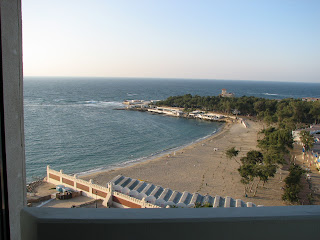For those who read my previous post on Alexandria and thought maybe we'd forgotten to go visit the new Library, au contraire. I just decided that it deserved its own posting. :)
You probably already know about the great ancient library of Alexandria, which reputedly held the sum total of knowledge available at that time. I don't know if this is true, but I've read that every ship which entered Alexandria's port was required to hand over some manuscripts for copying. Ptolomy I was very interested in translating other cultures' works into Greek. I hadn't realized that one of the first projects was assigning the translation of the Jewish scriptures to seventy rabbis, hence its name Septuagint, which means "Seventy" in Latin.
They aren't certain who was responsible for the library's destruction but it was burnt to the ground in the 4th century. In 1987, Egypt in joint partnership with other Arab countries and UNESCO, undertook the creation of a new library for Alexandria. A Norwegian company won the contract with its design and, $355 million later, the doors opened in 2002.
It's a very cool design.
The exterior of the building is engraved with letters, hieroglyphs, and pictograms from all the known languages.

The interior is well-designed, spacious, and uses natural light.


Those pillars remind me of Roman columns. It was an impressive building, but, apart from the many tour groups passing through, the place was dead. There were virtually no patrons and the staff didn't look like they had much to do. I don't know if this was due to the fact that it was Ramadan or maybe the adjoining University wasn't in session or both. I spent some time looking through the stacks and was surprised to find that their collection used the Dewey Decimal system and that it rivalled what you would find in a midsized public library in the States.
From what I've read, the library has mostly relied on donations from around the world. I found a Croatian cookbook as a gift from the government of Croatia, a Harlequin romance from some American women's group in Cairo, an old Sunset magazine book on Bathrooms (like one you'd find at Home Depot), some old Frommer's travel books from the 1990s....it's almost as if Americans just cleaned out their garages and sent their books here to help out the cause. :) I looked at their collection development policy on the website (www.bibalex.gov.eg) and it indicated that due to budget constraints, the library is focusing on building up its sections on Egypt and the Middle East while temporarily collecting at a very basic level in other areas. The library boasts electronic access to 35,000 periodicals and has several digital initiatives. I hope the Bibliotheka Alexandria becomes the beacon of knowledge and dialogue it is striving to become in the Middle East.
























